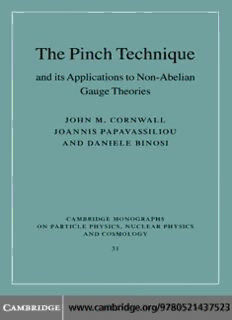
The Pinch Technique and its Applications to Non-Abelian Gauge Theories PDF
Preview The Pinch Technique and its Applications to Non-Abelian Gauge Theories
This page intentionally left blank THE PINCH TECHNIQUE AND ITS APPLICATIONS TO NON-ABELIAN GAUGE THEORIES Non-Abelian gauge theories, such as quantum chromodynamics (QCD) or electroweak theory, are best studied with the aid of Green’s functions that are gauge invariant off-shell, but unlike for the photon in quantum electrodynamics, conventional graphical constructions fail. The pinch technique provides a sys- tematic framework for constructing such Green’s functions and has many useful applications. Beginning with elementary one-loop examples, this book goes on to extend the methodtoallorders,showingthatthepinchtechniqueisequivalenttocalculations in the background-field Feynman gauge. The pinch technique Schwinger-Dyson equations are derived and used to show how a dynamical gluon mass arises in QCD. Applications are given to the center vortex picture of confinement, the gauge-invariant treatment of resonant amplitudes, the definition of non-Abelian effectivecharges,high-temperatureeffects,andevensupersymmetry.Thisbookis idealforelementaryparticletheoristsandgraduatestudents. john m. cornwall is Distinguished Professor of Physics Emeritus in the Department of Physics and Astronomy, University of California, Los Angeles. Inventor of the pinch technique, he has made many other contributions to the formalism and applications of quantum field theory, as well as to space plasma physics.Hehascontributedtothetechnicalanalysisofmanypublicpolicyissues, rangingfromballisticmissiledefensetothehumangenome. joannis papavassiliou is a researcher in the Department of Theoretical Physics and IFIC, the University of Valencia–CSIC. A large part of his work has beendevotedtothedevelopmentofthepinchtechnique,bothitsformalfoundation and its many applications, and he has published articles on quantum field theory andparticlephenomenology. daniele binosi is a researcherat the EuropeanCentre for Theoretical Studies ∗ in Nuclear Physics and Related Areas (ECT ) and Fondazione Bruno Kessler. In addition to his work on extending the pinch technique and its applications, he leads several policy-related European projects on the development of the vision andsustainabilityofquantuminformationfoundationsandtechnologies. CAMBRIDGE MONOGRAPHS ON PARTICLE PHYSICS, NUCLEAR PHYSICS AND COSMOLOGY GeneralEditors:T.Ericson,P.V.Landshoff 1. K.Winter(ed.):NeutrinoPhysics 2. J.F.Donoghue,E.GolowichandB.R.Holstein:DynamicsoftheStandardModel 3. E.LeaderandE.Predazzi:AnIntroductiontoGaugeTheoriesandModernParticlePhysics,Volume1: ElectroweakInteractions,the‘NewParticles’andthePartonModel 4. E.LeaderandE.Predazzi:AnIntroductiontoGaugeTheoriesandModernParticlePhysics,Volume2: CP-Violation,QCDandHardProcesses 5. C.Grupen:ParticleDetectors 6. H.GrosseandA.Martin:ParticlePhysicsandtheSchro¨dingerEquation 7. B.Anderson:TheLundModel 8. R.K.Ellis,W.J.StirlingandB.R.Webber:QCDandColliderPhysics 9. I.I.BigiandA.I.Sanda:CPViolation 10. A.V.ManoharandM.B.Wise:HeavyQuarkPhysics 11. R.K.Bock,H.Grote,R.Fru¨hwirthandM.Regler:DataAnalysisTechniquesforHigh-EnergyPhysics, Secondedition 12. D.Green:ThePhysicsofParticleDetectors 13. V.N.GribovandJ.Nyiri:QuantumElectrodynamics 14. K.Winter(ed.):NeutrinoPhysics,Secondedition 15. E.Leader:SpininParticlePhysics 16. J.D.Walecka:ElectronScatteringforNuclearandNucleonScattering 17. S.Narison:QCDasaTheoryofHadrons 18. J.F.LetessierandJ.Rafelski:HadronsandQuark-GluonPlasma 19. A.Donnachie,H.G.Dosch,P.V.LandshoffandO.Nachtmann:PomeronPhysicsandQCD 20. A.Hoffmann:ThePhysicsofSynchrotonRadiation 21. J.B.KogutandM.A.Stephanov:ThePhasesofQuantumChromodynamics 22. D.Green:HighPTPhysicsatHadronColliders 23. K.Yagi,T.HatsudaandY.Miake:Quark-GluonPlasma 24. D.M.BrinkandR.A.Broglia:NuclearSuperfluidity 25. F.E.Close,A.DonnachieandG.Shaw:ElectromagneticInteractionsandHadronicStructure 26. C.GrupenandB.A.Shwartz:ParticleDetectors,Secondedition 27. V.Gribov:StrongInteractionsofHadronsatHighEnergies 28. I.I.BigiandA.I.Sanda:CPViolation,Secondedition 29. P.JaranowskiandA.Kro´lak:AnalysisofGravitational-WaveData 30. B.L.Ioffe,V.S.FadinandL.N.Lipatov:QuantumChromodynamics:PerturbativeandNonperturbative Aspects 31. J.M.Cornwall,J.Papavassiliou,andD.Binosi:ThePinchTechniqueandItsApplicationstoNon-Abelian GaugeTheories THE PINCH TECHNIQUE AND ITS APPLICATIONS TO NON-ABELIAN GAUGE THEORIES JOHN M. CORNWALL UniversityofCaliforniaatLosAngeles,USA JOANNIS PAPAVASSILIOU UniversityofValencia–CSIC,Spain DANIELE BINOSI EuropeanCentreforTheoreticalStudiesinNuclearPhysicsand RelatedAreas,Italy cambridge university press Cambridge,NewYork,Melbourne,Madrid,CapeTown,Singapore, Sa˜oPaulo,Delhi,Dubai,Tokyo,MexicoCity CambridgeUniversityPress TheEdinburghBuilding,CambridgeCB28RU,UK PublishedintheUnitedStatesofAmericabyCambridgeUniversityPress,NewYork www.cambridge.org Informationonthistitle:www.cambridge.org/9780521437523 (cid:2)C J.Cornwall,J.Papavassiliou,D.Binosi2011 Thispublicationisincopyright.Subjecttostatutoryexception andtotheprovisionsofrelevantcollectivelicensingagreements, noreproductionofanypartmaytakeplacewithoutthewritten permissionofCambridgeUniversityPress. Firstpublished2011 PrintedintheUnitedKingdomattheUniversityPress,Cambridge AcatalogrecordforthispublicationisavailablefromtheBritishLibrary. LibraryofCongressCataloginginPublicationdata Cornwall,JohnM. Thepinchtechniqueanditsapplicationstonon-Abeliangaugetheories/JohnM.Cornwall,Joannis Papavassiliou,DanieleBinosi. p. cm.–(Cambridgemonographsonparticlephysics,nuclearphysics,andcosmology;31) Includesbibliographicalreferencesandindex. isbn978-0-521-43752-3 1.Quantumchromodynamics–Mathematics. 2.Gaugefields(Physics)–Mathematics. 3.Green’sfunctions. 4.Gaugeinvariance. I.Papavassiliou,Joannis. II.Binosi,Daniele. III.Title. QC793.3.Q35C675 2011 530.14(cid:3)35–dc22 2010034938 isbn978-0-521-43752-3Hardback CambridgeUniversityPresshasnoresponsibilityforthepersistenceor accuracyofURLsforexternalorthird-partyinternetwebsitesreferredto inthispublication,anddoesnotguaranteethatanycontentonsuch websitesis,orwillremain,accurateorappropriate. Toourfamiliesandfriends Contents Introduction:Whythepinchtechnique? pagexi 1 Thepinchtechniqueatoneloop 1 1.1 Abriefhistory 1 1.2 Notationandconventions 3 1.3 Thebasicone-looppinchtechnique 6 1.4 Anotherwaytothepinchtechnique 17 1.5 Pinchtechniquevertices 20 1.6 Thepinchtechniqueinthelight-conegauge 31 1.7 Theabsorptivepinchtechniqueconstruction 34 1.8 Positivityandthepinchtechniquegluonpropagator 42 References 43 2 Advancedpinchtechnique:Stilloneloop 45 2.1 Thepinchtechniqueandtheoperatorproductexpansion:Running massandcondensates 45 2.2 Thepinchtechniqueandgauge-bosonmassgeneration 47 2.3 Thepinchtechniquetoday:Background-fieldFeynmangauge 62 2.4 Whattoexpectbeyondoneloop 72 References 73 3 Pinchtechniquetoallorders 75 3.1 Thes-t cancellationtoallorders 75 3.2 Quark-gluonvertexandgluonpropagatortoallorders 79 References 85 vii viii Contents 4 ThepinchtechniqueintheBatalin–Vilkoviskyframework 86 4.1 AnoverviewoftheBatalin–Vilkoviskyformalism 88 4.2 Examples 93 4.3 PinchingintheBatalin–Vilkoviskyframework 100 References 102 5 Thegaugetechnique 104 5.1 TheoriginalgaugetechniqueforQED 105 5.2 Masslesslongitudinalpoles 108 5.3 ThegaugetechniqueforNAGTs 109 References 113 6 Schwinger–Dysonequationsinthepinchtechnique framework 114 6.1 Latticestudiesofgluonmassgeneration 115 6.2 Theneedforagauge-invarianttruncationschemeforthe Schwinger–DysonequationsofNAGTs 117 6.3 ThepinchtechniquealgorithmforSchwinger–Dysonequations 119 6.4 PinchtechniqueGreen’sfunctionsfromSchwinger–Dysonequations 120 6.5 SolutionsofthepinchtechniqueSchwinger–Dysonequationsand comparisonwithlatticedata 131 6.6 TheQCDeffectivecharge 134 References 141 7 Nonperturbativegluonmassandquantumsolitons 144 7.1 Notation 144 7.2 Introduction 144 7.3 Thequantumsolitons 150 7.4 Thecentervortexsoliton 152 References 165 8 Nexuses,sphalerons,andfractionaltopologicalcharge 167 8.1 Introductiontonexusesandjunctions 167 8.2 NexusesinSU(N) 170 8.3 TheQCDsphaleron 181 8.4 Chiralsymmetrybreakdown,nexuses,andfractionaltopologicalcharge 186 References 188 9 Abriefsummaryofd = 3NAGTs 190 9.1 Introduction 190
Description: